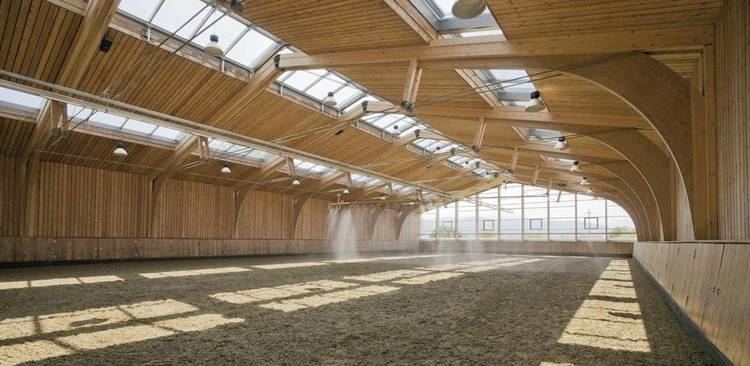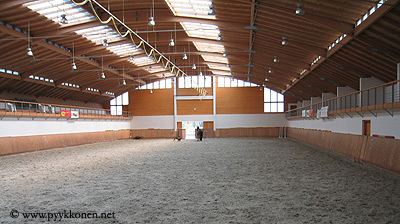Riding hall mov
A riding hall or riding arena is a building (part of an equestrian facility) that is specially designed for indoor horse riding. Smaller, private buildings contain only space for riding, while larger commercial facilities contain a "ring" or "Arena" within a larger building an exclusively for equestrian use, but may also incorporate additional facilities for spectators or stabling of horses.
Contents
- Riding hall mov
- Building Design
- Construction
- Functional Design
- Special purpose halls
- Famous riding halls
- References

Building Design

Riding halls enable horses and riders to train or compete in dry conditions regardless of the weather. There are various designs. The most popular are either steel girder or timber framed buildings, with wood, brick or sheet metal panels. Roofs can be made of various materials including sandwich panels, corrugated steel, or in smaller buildings, wood. In some cases, stables are built either next to or attached to a riding Hall, sometimes under the same roof. In addition, tension fabric buildings are also used as arenas. These textile buildings usually consist of an aluminium frame and a high-strength PVC-covered sheet roof as well as wind protection or windbreak(er) netting in the walls.
Construction
Riding halls are built with the following criteria in mind:
Government approval, building permits, or other official permissions are often required to build riding halls. Buildings intended for commercial or public uses may also have stands or other seating included with the structure. Facilities such as toilets or concessions may be included in a commercial facility.
Functional Design

Riding halls are not heated because this is healthier for the horses and most arenas have tournament standard dimensions of 20 x 60 metres or of 20 x 40 metres and 25 x 65 metres.
Of great importance is the floor quality. Floors often consist of a top layer of 100mm of silica sand over a complex aggregate substrate designed to ensure proper drainage. A good riding floor needs to have the right level of moisture content to reduce the amount of dust, aid maintenance and ensure good rideability. This may be achieved by an automatic floor watering facility – whereby the floor is watered from sprinklers above it – or by regular watering from below the surface.
Lighting is also particularly important. The sensitivity of horses to dark and light makes it essential to have consistent lighting. Artificial light need to be diffused and non-dazzling and brightness needs to be adjustable depending on the riding discipline being performed.
Special purpose halls
A lungeing hall is a smaller hall for lungeing horses. Most lungeing halls are circular and have a diameter of 16–24 metres. Rectangular designs may be cheaper to build and give horses a better spatial orientation. Lungeing halls also generally needs building permission.
